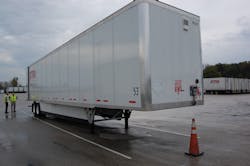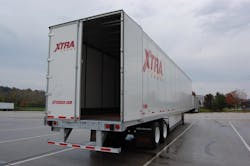Steven Porter will tell you that longevity is probably the most critical aspect of a dry van trailer, and as a result, that aspect guides most of the design and spec’ing strategies where such trailers are concerned.
Porter, director of equipment services for XTRA Lease with 31 years of experience in the trailer market, noted that even small design changes – such as putting nuts on floor screws at the “high torque” points on a trailer, especially next to the fifth wheel – will reduce repair and maintenance costs over the lifespan of a typical dry van unit; trailers expected to last anywhere from 15 to 20 years in service.
Porter explained to Fleet Owner during a visit to one of the company’s branch locations just outside of St. Louis that XTRA Lease typically keeps its dry trailers in over-the-road service for 10 years, followed by three years in “cartage” or regional/local operation, followed by two years in storage service.
To get that full 15 years, though, requires a data-driven focus on durability factors, Porter pointed out.
“We really look at durability, cost and weight,” he explained. For example, XTRA Lease specs its dry van trailer crossmembers at 10-in. intervals versus the 12-in. standard, boosting its floor-loading rating to 24,000 lbs. from the typical 18,000 to 20,000 lbs. in order to help them hold up better under repeated pounding from forklifts.
“We want to keep that floor from deteriorating or buckling,” Porter stressed. “But a spec is only a spec; it can’t truly become a ‘good’ spec unless it provides value, especially to our customer.”
That’s also partly why XTRA Lease tries to maintain steady influx of new trailer units into its fleet, noted Ron Kemm, the company’s director of marketing.
“By investing in new trailers at regular intervals, we gain the innovations trailer OEMs and their suppliers are working on, as well as giving customers newer units,” he said.
And the need for such trailer “innovation” isn’t going away anytime soon, especially as tractor-trailers as a unit need to gain better fuel efficiency in line with the new Phase 2 greenhouse gas (GHG) rules, noted Jeff Talaga, vice president of sales and strategic development for the Americas at SAF-Holland.
“The GHG rules are definitely going to affect the dry van and refrigerated markets; they [the rules] represent long-term impact and it’s going to require a step by step process to get there,” he explained to Fleet Owner during a press event in St. Louis.
Talaga added that though dry van trailer orders are expected to drop 10% to 15% in 2017 versus this year, work is going to continue apace on ways to make dry van units lighter and more cost effective.
“There’s a lot of extra weight from all of the aerodynamic devices being added to [dry van] trailers to help them comply with the GHG mandates,” he said – some 400 to 500 lbs. worth where side fairings and trailer “tail” devices are concerned, according to SAF-Holland.
“That’s why the OEMs are looking to us to help balance that [weight gain] out,” Talaga noted, through lighter components such suspension systems.
Yet he also stressed such “light-weighting” efforts can’t come at the expense of longevity or performance. “We are still trying to make components as ‘bulletproof’ as possible,” Talaga pointed out.
As an example, he noted that SAF-Holland is making the walls of its trailer axles 12% thicker to help stop axle “deflection” which can compromise trailer life cycle targets over time “It’s all a balancing act,” Talaga explained.
XTRA Lease’s Porter noted that many trailer makers are now experimenting with “super glues” to “bond” sidewalls, ceilings, and other structural components together – forgoing traditional steel rivets almost entirely – along with the wider use of lighter composite materials as well.But the trick with such new designs is not only how they will hold up over the long term but how they impact maintenance and repair practices, too.
“The big issue when you change a design or material is how you repair it; and not just for our technicians, but for the ones our customers might use for road–side service,” Porter pointed out.
Because even a small trailer issue can grow large when companies like XTRA Lease are buying thousands of units annually and planning on keeping them in service for a decade and a half or longer.
“More often than not, too, a problem with a [trailer] design change will occur five or six years down the road, not when you first put it in to service,” Porter emphasized. “That’s why the overall integrity of the trailer is key for long-term use.”
About the Author
Sean Kilcarr
Editor in Chief
Sean Kilcarr is a former longtime FleetOwner senior editor who wrote for the publication from 2000 to 2018. He served as editor-in-chief from 2017 to 2018.



